THE STONE LANTERN
石灯籠
The use of the stone lantern in gardens seems almost certainly to be owing to the Tea Masters, who adapted it from the Buddhist temple where it originated.
庭にある石灯籠は、茶人達によって一般化したと言って過言ではありません。もともとは、仏教寺院にその起源はあります。
This may be seen from the name of the various shapes which are almost all taken from temples or from the Tea masters who designed them.
種類の多くはその石灯籠があったお寺の名前から名付けられ、また、茶人がデザインした物もあります。
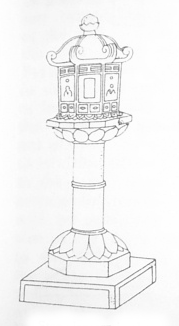

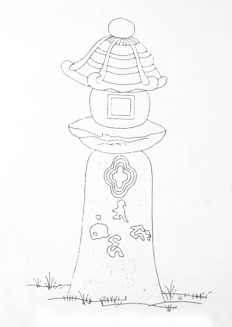
left:Stone lantern in the Tachibana-dera near Nara, the birthplace of Shotoku Taishi. It is said to be the oldest stone lantern in the country.
左:奈良近郊橘寺にある石灯籠。聖徳太子誕生の地で最古の石灯籠と言われている。
middle:Bronze lantern befor the Todaiji at Nara. Tempo period (728-746). Evidently the oldest specimen of a standing lantern and the ancestor of those of stone.
中央:奈良東大寺にある銅製の灯籠。天保(728〜746)このような立っている形としては、明らかに、もっとも古い、灯籠の先祖である。
right:Stone lantern in Count Matsuura's garden at Asakusa. Tradition says it was presented by Shizuka Gozen to the Shrine of Hachiman at Kamakura in the 12th century.
右:浅草松浦伯爵邸にある石灯籠。12世紀、静御前が鎌倉八幡宮に献上したと言われている。
Thus we have "Kasuga," "Nigatsudo," "Uzumasa," and "Daibutsu," shapes associated with the most ancient Buddhist architecture of the Nara age and decorated moreover with lotus and jewel motif on the cap.
例として、春日、二月堂、太秦、大仏などの名前があります。その多くは奈良時代の仏教寺院からとられていて、頭部分には蓮や宝石がモチーフとしておかれています。
These lanterns most probably developed from the hanging lanterns of bronze or wood which were originally used about temples and are a good example of Japanese eclectic taste, for they have not involved in this way in China whence the temple architecture was brought.
それは銅製や木製で作られ、中国文化模倣のみではなく、とりいれて作ると言う日本の折衷文化の特色がよく現れています。
A further simplification is seen in the Miya-gata or Shinto Shape, which follows the severer lines of a Japanese Shinto Shrine.
簡素化かとでも言うべきでしょうか、これは、日本の神社スタイルに置き換えられています。
Practically all the others, designed for garden use by the Tea masters, are of even simpler form, and for the Tea-garden especially lanterns made of natural uncut stones are preferred.
茶人が使用するためにデザインした庭は、実際にその多くは庭の模倣として存在し、灯籠は趣を出すために自然の石が加工されずにおかれることがよしとされています。

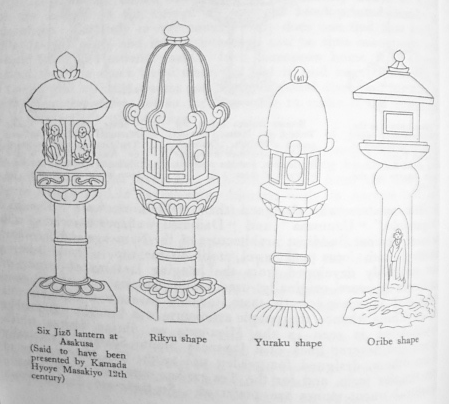
So there are Shuko, Sho-o, Sowa, Soeki, Rikyu, Oribe and Enshu shaps, to mention only the most famous names, and these were afterwards modified and made in various styles.
現に、珠光、紹鴎、SOUWA、SOEKI、利休、織部、遠州など茶人の名前をとった灯籠の形が代表としてあります。その後、これらを本歌に改良され、様々なスタイルの灯籠が生まれました。
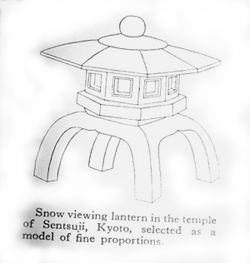
The type called Snow-viewing lantern is much appreciated in the Roji both in the more formal as well as in the rougher shapes made of natural stone.
雪見灯籠と呼ばれるものは前記の自然石で出来た荒削りのものと同様に露地においてよく鑑賞されるものの一つです。
Lanterns are placed by the gate of the Roji, by the Water Basin, beside the entrance to the Tea-room, by the Waiting Arbor and by the Setsuin, but it is not good taste to put them at all these place, for they will look monotonous like street lamps.
灯籠は露地の入り口や手水鉢、茶室の入り口、待合や雪隠の横などに置かれますが、すべてに置かれるのではありません。露地を照らすモノトーンの演出としての役目が重要なのです。
So if, for instance, one is placed by the Tea-room, those by the Water Basin, the Waiting Arbor or the Gate are better omitted, and if Gate and Water Basin have them it is well to leave them out at the other points.
例えば、茶室の横に置かれた時は手水鉢や待合、入り口は置かれません。逆に、入り口や手水鉢に置かれている場合は、他の場所は置かれないと言うことです。
Moreover, a tree should always be planted beside the lantern so that one branch hangs over or in front of the top. This branch is called the Hi-sawari or Light-obscuring Branch.
さらに、灯籠の横には常に木が一本植えられていてその木の枝が灯籠の前に一本出ています。これを"火障りの枝"と言って直接の灯りを遮る役目をしています。
This is specially important in the case of the Snow-viewing class of lantern, for it adds very much to the effect.
この演出は雪見灯籠を置く場合は特に大切です。
Since these lanterns are not used to illuminate the garden but to lend an added charm and interest to the scene they must not no any account be overdone.
だから、灯籠は庭を照らすだけの役目と言うよりは、他を加えずに魅力的な雰囲気を出すためにあるのです。
They are not useless ornaments, however, for they are necessary at dawn and evening Tea to indicate the position of the various points in the Roji and guide in the dark, and it was for this reason that they were first introduced into it. A lantern is never placed where light would not be needed.
しかしながら飾りだけと言うことでもないのです。暗くなった露地を灯す役割としてそこに置かれているのはたしかですが、明かりだけの役目ではないと言うのもたしかなのです。
Three at most will be sufficient according to the Roji, one as an addition to the scenery of a grouping and the other two at place where light would be required as by the Water Basin or Gate.
露地には三個で十分です。一つは景色として、二つは手水鉢と門を照らす役目です。
Or two or even only one will often be quite sufficient.
または、一個か二個の場合も多々あります。
According to some Tea Masters where a stone lantern has a "New Moon" shaped opening in its top this should always be turned toward the west, while a Full Moon shaped one should be turned toward the east, but others consider this of no great importance and prefer to turn the lantern so that the light looks best in the garden.
茶人達は東向きの灯籠を新月、西向きを満月に見立てると言う場合もありますが、庭を照らすことが主でさして重要な決まり事ではありません。
Lanterns are always arranged with stones according to the usual rhythmic order of grouping, the lantern taking the place of the Upright Torso Stone as the principal element in the group.
灯籠はリズミカルな石の構成で火を灯す石がもっとも主要な石です。
There may be two or three other stones in the group and the Lamp Lighting Stone at one side is often stepped.
二から三個の石を使い組み上げて火袋石をその上に置きます。
Concerning the earliest history of the Stone Lantern there is the following record in the temple of Tachibana in Unebi in the province of Yamato: "Irihi-no-ko-no-O-kami after he had made a lake in the hill in Nii-gori in the province of Kawachi, heard that bandits often frequented the road by the side of it, which was a particularly lovely place, and attacked at night and despoiled them of their goods and sometimes of their lives, so he had a lantern made of stone and placed it there, and this work he entrusted to his younger brother Ishizukuri-no-kami, saying that stone was strong but did not crush benevolence and fire was positive and conquered darkness, and by this means he did away the evil.
石灯籠の歴史は大和の国畝傍(うねび)橘寺の記録に見るとが出来ます。イリヒコノオオカミがニイゴリと言う丘に一つの湖を創りました。ある時、山賊が出現して人々から強奪や命までも獲る事件がその湖畔の道で度々起こることを彼は聞きました。そこで、石の灯籠を作り夜道を照らし、その管理を弟であるイシズクリノカミに託しました。その石は慈悲の愛を失うことはなく、こうこうとあたりを照らし暗闇や悪を封じ込めました。
And this is the first lantern to be made of stone on Japan.
この石作りの灯籠が日本で初めての物なのです。
And sine the Mausoleum of his son Miyaku-no-kami is in this temple according to tradition, this lantern has been removed and erected here."
彼の子供であるミヤクノカミの陵は伝統に従ってこの寺にあり、灯籠も移築されここに置かれました。
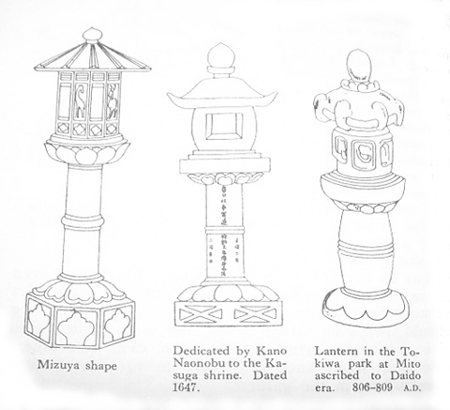
Now this temple was built by Shotoku Taishi, son of the thirty-third Sovereign Suiko Tenno.
このお寺は推古天皇時代の皇子である聖徳太子によって建てられました。
Now concerning this Irihi-no-ko-no-kami, the eleventh Earthly Sovereign Suijin Tenno named Ikume-Irihiko-Isachi-no-mikoto, who reigned in the place of Shuiki Tamagaki, married the younger sister of Saho-hiko-no-mikoto and had a son Ha-mutsu-wake-no-mikoto, and he married the daughter of Tama-no-ushi-no-o, who is the Prince referred to above.
現在記録に残っているのは、イリヒノコノカミはスイキタマガキを治めた十一代垂仁天皇と関係があるとせれています。妹であるサホヒコノミコトと結婚し、ハムツワケノミコト生み、そして彼はタマノウシノオの娘と結婚して皇子にまでなりました。
And in the Kojiki it is recorded that Inishiki-no-Irihi-ko-no-mikoto, made the lake Chinuma and also the lake Sayama, and so it seems that this lake Sayama is the one referred to in the temple annals.
そして、古事記と言う読み物に、イニシキノイリヒコノミコトがチヌマと言う湖とサヤマと言う湖を作ったと記憶があります。とくにサヤマ湖はそこを統治したと寺の年代記に書いてあります。
And moreover his younger brother Ishizukuri-no-kami may be identified with Iwatsuku-wake-no-mikoto, and his son Miyaku-no-kami, whose mausoleum is in the Tachibana temple, may be that Mio-no-kami, who is referred to as Hagui-no-kami, ancestor of the lords of Mio and descendant of Ishizukuri-no-kami.
さらに、彼の弟であるイシズクリノカミはイワツクワケノミコトと同一人物であり、彼の子供のミヤクノカミとともに橘寺に陵墓があります。よって、たぶん、ミオノカミはハグイノカミの先祖でイシズクリノカミの子孫にあたると思います。
The only objection to this tradition, says Tamaki Issai, in quoting it, is that it seems that this lantern bears on its head something that looks like a Buddhist figure, and also has what appears to be a lotus design on its base, whereas Buddhism was not introduced into Japan till the time of Kimmei Tenno some five hundred years after the period of the Emperor Suijin (about 50 B.C.) to which it is referred.
この話にちょっとした疑問をていしているのが Tamaki Issaiと言う人です。彼は、灯籠の上部が仏様の形をしていることや蓮の花のモチーフが使われていることを指摘して、仏教伝来は垂仁天皇から約500年、欽明天皇(きんめいてんのう)の時代にならないとないとしています。
It certainly does not seem so likely that stone lanterns of any kind were used before the introduction of Buddhism, since the oldest specimens show these signs of Buddhist influence.
どう考えても石灯籠は仏教以降のもので、もっとも古い標本的古物も仏教趣味が反映されているのです。
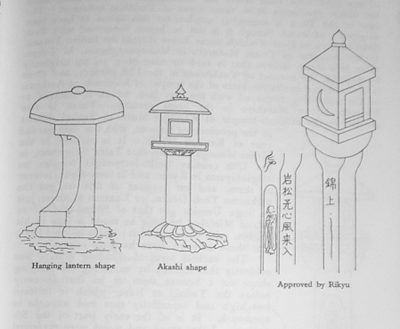
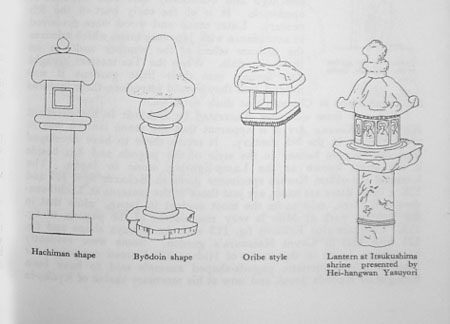
The case of the Torii is somewhat similer, for this seems to have been originally of wood, though it is not in Japan connected with Buddhist edifices, in spite of which some derive it from the Indian Torena.
鳥居の方がむしろそれに近いかもしれません、木材を使ったものであると理由から考えられるのです。日本における仏教体系との係わりというよりは、Indian Torenaによって得たと言うべきでしょうか。
In the mansion of Count Matsuura in Mukoyanagiwara, in Tokyo, there is a stone lantern that is said to have been set up originally by Shizuka, the consort of Yoshitsune in the 12th century, and there is also another in the precincts of the temple of Kwannon at Asakusa, in the same city, engraved with the Six Jizo, which is referred to Kamada Hyoye Masakiyo in the same century.
東京の向柳原にある松浦伯爵の邸宅に静御前によって建立されたと言われる石灯籠があります。彼女は義経の愛人として12世紀に実在したと言われる人です。また、他にも浅草観音境内にも六地蔵という石灯籠があり、kamada Hyoye Masakiyoが好んだとされています。
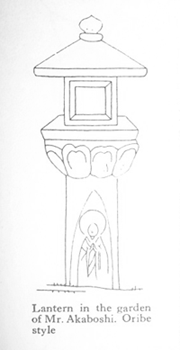
There is also another in the Hozenji temple at Kawajiri Mura in Tsukui district in the province of Sagami, with the date Second year of Kenkyu (1192).
他にも相模の国、現在の神奈川県津久井郡城山町の宝泉寺灯籠があります。
It is written in the Heike Monogatari also that Taira Shigemori, in the 12th century built forty eight temples on in them, and on account of this he got the nickname Toro Daijin, or Lantern Minister, just as Soga Umako got that of Shima-no-Omi or Lsland Minister because he made a lake in his garden, with as island in it; but it is most likely that these lanterns were hanging ones.
これは12世紀の平家物語という書物に書かれた平重盛という大臣の話で、48の寺に灯籠を建立したとされています。かれはこの功績により灯籠大臣と呼ばれました、いわゆる蘇我馬子が島の臣と呼ばれたことと同様に湖を作りその島を作った人と言う意味です。ちなみに、この灯籠はつり下げ型だった様です。
The earliest from of standing lantern was evidently that formed by mounting the hanging shape on a bronze stem as in that formerly befor the Todaiji at Nara, which is thirteen feet high and beautifully cast and wrought in openwork.
初期の灯籠は明らかに山なりで銅の茎の形をした様なものにつり下げられていて、奈良東大寺に現存しています。高さが約9メートルあり素晴らしい透かし彫り細工が施されています。
It is of the early part of the 8th century.
8世紀初め頃の作品だと思われます。
Later stone and wood were preferred in accordance with Japanese taste, which admires the delicate effect of the weather and age on these materials.
以来、石と木はその年月や風化による微妙な変化が、日本の趣向として好まれました。
When the Tea masters brought Zen feelings into their little gardens it was natural that they should introduce these lanterns for convenience at Cha-no-yu at dusk or dawn.
茶人がその庭へ持ち込んだ禅の思想は自然であり、茶の湯においてこれらの灯籠は黄昏や夜を演出するにはとても便利なものだったのです。
But now from examples illustrated by Eckardt in his excellent History of Korean Art it is apparent that the stone lantern was in use in Korea in the 8th century.
ここにEckardtという人が出版したHistory of Korean Artという素晴らしい作品があります。これによるとKoreaでは8世紀に石灯籠は使われていました。
It seems there to have developed from the incense burner in the style of the pagoda and has beside it the stone known as the Lamp-lighting stone in Japan.
それによると、塔の形をした物の中で線香を焚きその横に日本同様の石灯籠が置かれています。
The 128, if these dates are exact, are just those of the lanterns at Tachibanadera, and Nara, said to be the most ancient in Japan, while that in the Tokiwa park at Mito is very reminiscent of the pagoda of fig.115.
128番はまさに奈良、橘寺のもっとも古いとされている物と同じで、115番は水戸にある常磐邸の塔の姿を思い起こさせるものなのです。
Compare also Eckardt fig.113 with the Mizuya shape and fig.121 with that in Count Matsuura's garden.
113番は水屋を連想させ、121番は松浦伯爵邸を連想させます。
Some were evidently brought to Japan in the course of Hideyoshi's Korean campaign, for there is a characteristic pagoda-shaped example said to have been brought by Kuroda Josui, and now at his mortuary shrine of Ryuko-in at Daitokuji, Kyoto.
明らかに、これらは秀吉の朝鮮出兵における出来事が起因しています。例えば、黒田如水の墓所である京都大徳寺のRyuko−inの塔の形かよい例です。
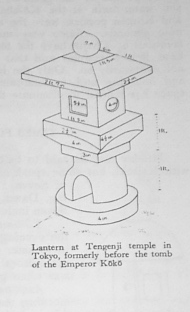

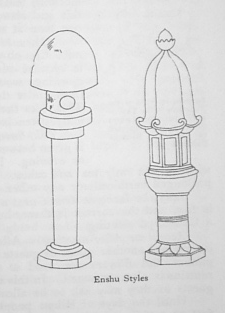
Hosokawa also brought one of the foundation stone of one of the gates of Seoul for a water-basin, and the Fusen water-basin at the Ko-hoan looks like another.
細川氏もまたソウルの門から化粧石を持ち帰り手水鉢にしたりして、Ko−hoanの手水鉢やその他がそうです。
Such things, and Korean potters, were the souvenirs most preferred by the Japanese generals.
朝鮮の陶工を土産に連れ帰ることが一番喜ばれたことを含め、日本の一般的な状況だったのです。
Since very many lanterns found in the Roji and favoured by Chajin have the foot buried in the ground whithout any base, it is sometimes said that only this kind is correct, but this is not necessarily so.
露地における茶人趣味の多くの灯籠は基礎無しでそこに置かれています。それはまず間違いなく、そこにどうしても置かなければならなかったものではないと言うことです。
Only the inclination to avoid anything elaborate and imposing and to maintain the proper proportion in a small space has tended to eliminate the base.
茶の湯の小さな庭において、精巧さや華やかさを求めない、しかしその厳粛さを維持する為にはこの明かりが根本を照らしたのだと思います。
INTRODUCTION-1 TITLE CONTENTS